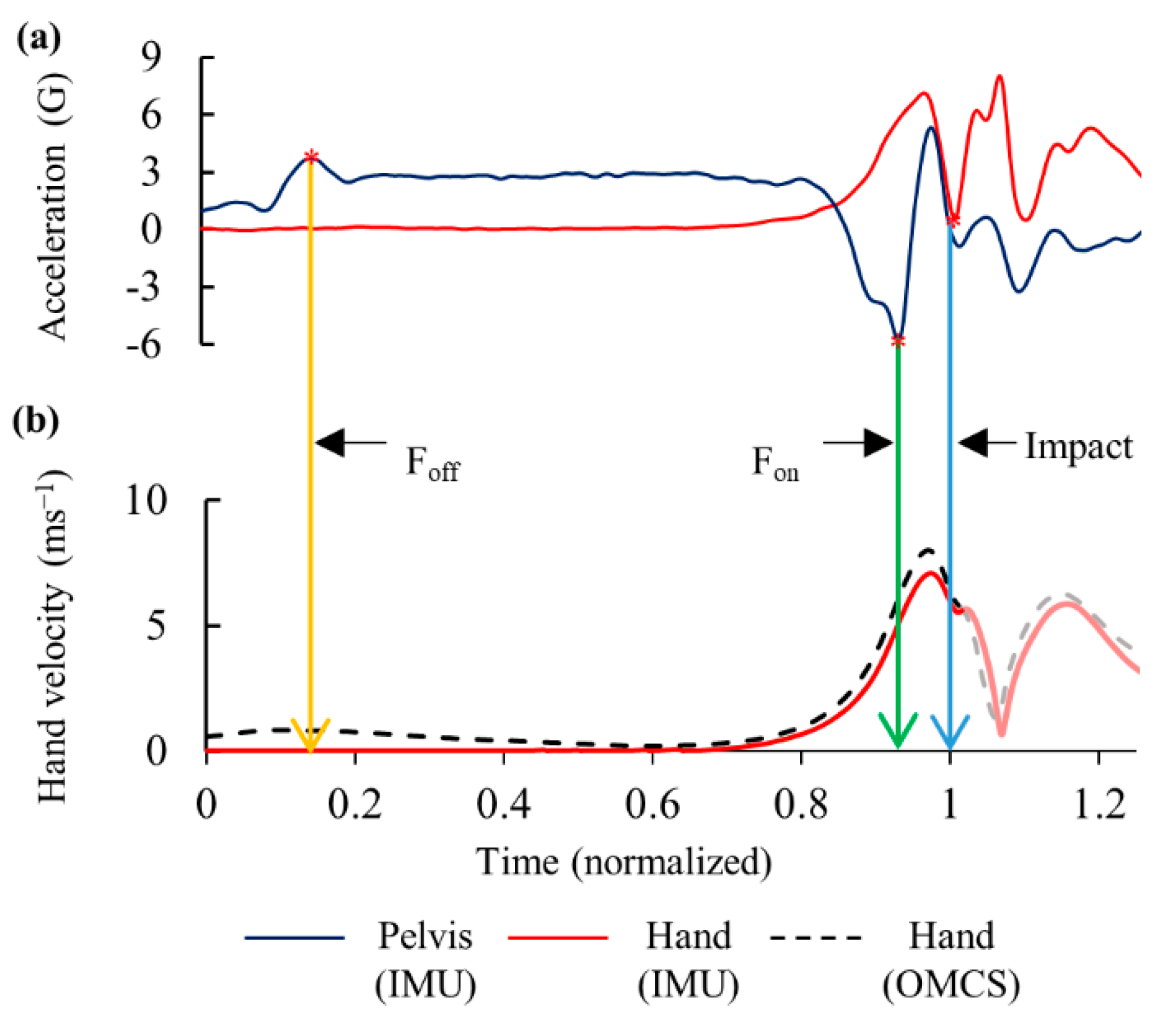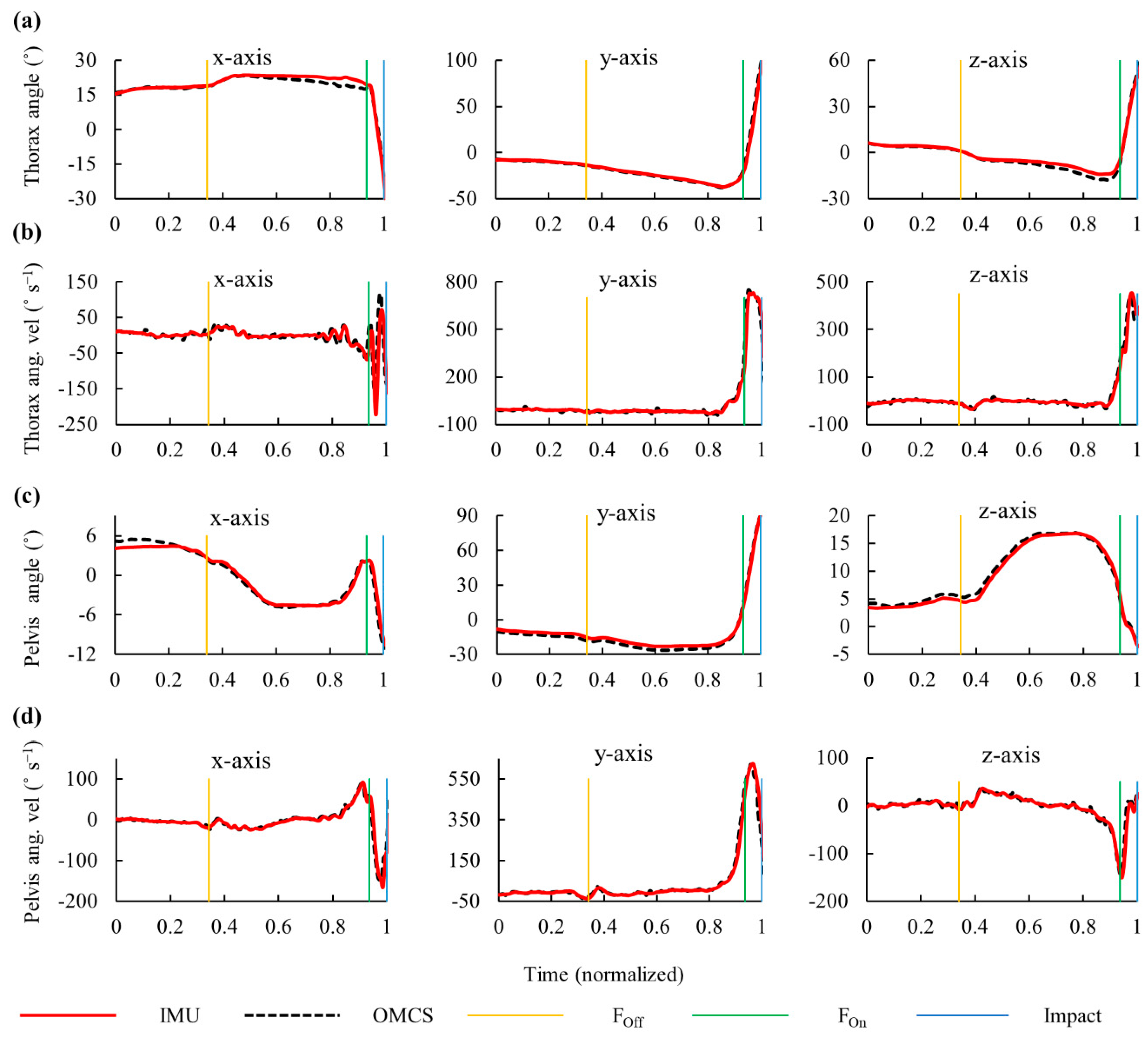Efficacy of Inertial Measurement Units in the Evaluation of Trunk and Hand Kinematics in Baseball Hitting
Abstract
1. Introduction
2. Materials and Methods
2.1. Participants
2.2. Instrumental Setup
2.3. Data Collection during Hitting Motion
2.4. Calculation of Kinematic Parameters
2.5. Estimation of Hitting Events and Hand Motion
2.6. Kinematic Data Validation with the OMCS
2.7. Statistical Analysis
3. Results
3.1. Swing Description Using IMUs
3.2. Validity and Reliability of IMUs
4. Discussion
5. Conclusions
Author Contributions
Funding
Acknowledgments
Conflicts of Interest
References
- Williams, T.; Underwood, J. The Science of Hitting; Simon & Schuster: New York, NY, USA, 1986; ISBN 9780671621032. [Google Scholar]
- Ae, K.; Koike, S.; Fujii, N.; Ae, M.; Kawamura, T. Kinetic analysis of the lower limbs in baseball tee batting. Sports Biomech. 2017, 16, 283–296. [Google Scholar] [CrossRef]
- Reyes, G.F.; Dickin, D.C.; Crusat, N.J.K.; Dolny, D.G. Whole-body vibration effects on the muscle activity of upper and lower body muscles during the baseball swing in recreational baseball hitters. Sports Biomech. 2011, 10, 280–293. [Google Scholar] [CrossRef] [PubMed]
- Szymanski, D.J.; McIntyre, J.S.; Szymanski, J.M.; Jason Bradford, T.; Schade, R.L.; Madsen, N.H.; Pascoe, D.D. Effect of torso rotational strength on angular hip, angular shoulder, and linear bat velocities of high school baseball players. J. Strength Cond. Res. 2007, 21, 1117–1125. [Google Scholar] [CrossRef] [PubMed]
- Conte, S.A.; Thompson, M.M.; Marks, M.A.; Dines, J.S. Abdominal muscle strains in professional baseball. Am. J. Sports Med. 2012, 40, 650–656. [Google Scholar] [CrossRef] [PubMed]
- Shaffer, B.; Jobe, F.W.; Pink, M.; Perry, J. Baseball batting: An electromyographic study. Clin. Orthop. Relat. Res. 1993, 292, 285–293. [Google Scholar] [CrossRef]
- Fleisig, G.S.; Hsu, W.K.; Fortenbaugh, D.; Cordover, A.; Press, J.M. Trunk axial rotation in baseball pitching and batting. Sports Biomech. 2013, 12, 324–333. [Google Scholar] [CrossRef]
- Cuesta-Vargas, A.I.; Galán-Mercant, A.; Williams, J.M. The use of inertial sensors system for human motion analysis. Phys. Ther. Rev. 2010, 15, 462–473. [Google Scholar] [CrossRef]
- Al-Amri, M.; Nicholas, K.; Button, K.; Sparkes, V.; Sheeran, L.; Davies, J. Inertial measurement units for clinical movement analysis: Reliability and concurrent validity. Sensors 2018, 18, 719. [Google Scholar] [CrossRef]
- Nüesch, C.; Roos, E.; Pagenstert, G.; Mündermann, A. Measuring joint kinematics of treadmill walking and running: Comparison between an inertial sensor based system and a camera-based system. J. Biomech. 2017, 57, 32–38. [Google Scholar] [CrossRef]
- Stančin, S.; Tomažič, S. Time- and computation-efficient calibration of MEMS 3D accelerometers and gyroscopes. Sensors 2014, 14, 14885–14915. [Google Scholar] [CrossRef]
- Sailboat Instruments. Improved Magnetometer Calibration (Part 2). Available online: http://sailboatinstruments.blogspot.com/2011/09/improved-magnetometer-calibration-part.html (accessed on 14 May 2020).
- Li, Q.; Griffiths, J.G. Least squares ellipsoid specific fitting. In Proceedings of the Geometric Modeling and Processing 2004, Beijing, China, 13–15 April 2004. [Google Scholar]
- De Vries, W.H.K.; Veeger, H.E.J.; Baten, C.T.M.; van der Helm, F.C.T. Magnetic distortion in motion labs, implications for validating inertial magnetic sensors. Gait Posture 2009, 29, 535–541. [Google Scholar] [CrossRef] [PubMed]
- Madgwick, S.O.H.; Harrison, A.J.L.; Vaidyanathan, R. Estimation of IMU and MARG Orientation using a Gradient Descent Algorithm. In Proceedings of the 2011 IEEE International Conference on Rehabilitation Robotics, Zurich, Switzerland, 29 June 2011; Volume 2011, pp. 1–7. [Google Scholar]
- Yi, C.; Ma, J.; Guo, H.; Han, J.; Gao, H.; Jiang, F.; Yang, C. Estimating three-dimensional body orientation based on an improved complementary filter for human motion tracking. Sensors 2018, 18, 3765. [Google Scholar] [CrossRef] [PubMed]
- Wilson, S.; Eberle, H.; Hayashi, Y.; Madgwick, S.O.H.; McGregor, A.; Jing, X.; Vaidyanathan, R. Formulation of a new gradient descent MARG orientation algorithm: Case study on robot teleoperation. Mech. Syst. Signal Process. 2019, 130, 183–200. [Google Scholar] [CrossRef]
- Kuipers, J.B. Quaternions and rotation sequences. In Proceedings of the International Conference on Geometry, Integrability and Quantization; Mladenov, I.M., Naber, G.L., Eds.; Institute of Biophysics and Biomedical Engineering, Bulgarian Academy of Sciences: Sofia, Bulgaria, 2012; pp. 127–143. [Google Scholar]
- Diebel, J. Representing Attitude: Euler Angles, Unit Quaternions, and Rotation Vectors; Stanford University Press: Stanford, CA, USA, 2006. [Google Scholar]
- Grood, E.S.; Suntay, W.J. A joint coordinate system for the clinical description of three-dimensional motions: Application to the knee. J. Biomech. Eng. 1983, 105, 136–144. [Google Scholar] [CrossRef]
- Wu, G.; Siegler, S.; Allard, P.; Kirtley, C.; Leardini, A.; Rosenbaum, D.; Whittle, M.; D’Lima, D.D.; Cristofolini, L.; Witte, H.; et al. ISB recommendation on definitions of joint coordinate system of various joints for the reporting of human joint motion—Part I: Ankle, hip, and spine. J. Biomech. 2002, 35, 543–548. [Google Scholar] [CrossRef]
- Cole, G.K.; Nigg, B.M.; Ronsky, J.L.; Yeadon, M.R. Application of the joint coordinate system to three-dimensional joint attitude and movement representation: A standardization proposal. J. Biomech. Eng. 1993, 115, 344–349. [Google Scholar] [CrossRef]
- Punchihewa, N.G.; Yamako, G.; Fukao, Y.; Chosa, E. Identification of key events in baseball hitting using inertial measurement units. J. Biomech. 2019, 87, 157–160. [Google Scholar] [CrossRef]
- Graf, B. Quaternions and dynamics. arXiv 2008, arXiv:0811.2889. [Google Scholar]
- Tabuchi, N.; Matsuo, T.; Hashizume, K. Bat speed, trajectory, and timing for collegiate baseball batters hitting a stationary ball. Sports Biomech. 2007, 6, 17–30. [Google Scholar] [CrossRef]
- Koo, T.K.; Li, M.Y. A Guideline of selecting and reporting intraclass correlation coefficients for reliability research. J. Chiropr. Med. 2016, 15, 155–163. [Google Scholar] [CrossRef]
- Pasciuto, I.; Ligorio, G.; Bergamini, E.; Vannozzi, G.; Sabatini, A.; Cappozzo, A. How angular velocity features and different gyroscope noise types interact and determine orientation estimation accuracy. Sensors 2015, 15, 23983–24001. [Google Scholar] [CrossRef] [PubMed]
- Altman, D.G.; Bland, J.M. Measurement in medicine: The analysis of method comparison studies. J. R. Stat. Soc. 1983, 32, 307. [Google Scholar] [CrossRef]
- Putnam, C.A. Sequential motions of body segments in striking and throwing skills: Descriptions and explanations. J. Biomech. 1993, 26, 125–135. [Google Scholar] [CrossRef]
- Dowling, B.; Fleisig, G.S. Kinematic comparison of baseball batting off of a tee among various competition levels. Sports Biomech. 2016, 15, 255–269. [Google Scholar] [CrossRef]
- Welch, C.M.; Banks, S.A.; Cook, F.F.; Draovitch, P. Hitting a baseball: A biomechanical description. J. Orthop. Sports Phys. Ther. 1995, 22, 193–201. [Google Scholar] [CrossRef]
- Escamilla, R.F.; Fleisig, G.S.; DeRenne, C.; Taylor, M.K.; Moorman, C.T.; Imamura, R.; Barakatt, E.; Andrews, J.R. A comparison of age level on baseball hitting kinematics. J. Appl. Biomech. 2009, 25, 210–218. [Google Scholar] [CrossRef]
- Ae, K.; Koike, S.; Kawamura, T. Kinetic function of the lower limbs during baseball tee-batting motion at different hitting-point heights. Sports Biomech. 2018, 452–466. [Google Scholar] [CrossRef]
- Winter, D.A. Biomechanics and Motor Control of Human Movement, 4th ed.; John Wiley and Sons: Hoboken, NJ, USA, 2009; ISBN 9780470549148. [Google Scholar]
- Duc, C.; Salvia, P.; Lubansu, A.; Feipel, V.; Aminian, K. A wearable inertial system to assess the cervical spine mobility: Comparison with an optoelectronic-based motion capture evaluation. Med. Eng. Phys. 2014, 36, 49–56. [Google Scholar] [CrossRef]






| Segment/Joint | Axis | RMSE (°) (Angular Displacement) | MAE (%) (Angular Velocity) |
|---|---|---|---|
| Thorax | x | 2.16 | 5.06 |
| y | 3.78 | 3.66 | |
| z | 2.64 | 2.37 | |
| Pelvis | x | 1.57 | 5.58 |
| y | 1.94 | 1.59 | |
| z | 1.36 | 2.13 | |
| Spine | Flexion (ML) 1 | 2.69 | 4.14 |
| Lateral flexion (AP) 2 | 1.83 | 1.37 | |
| Axial rotation (long) 3 | 1.49 | 4.48 |
| Angular Displacement at the Impact (°) | Peak Angular Velocity (°s−1) | ||||||||
|---|---|---|---|---|---|---|---|---|---|
| Segment/Joint | Axis | Mean (SD) | Bias | LOA (UB, LB) | ICC | Mean (SD) | Bias | LOA (UB, LB) | ICC |
| Thorax | x | −21.2 (4.8) | −1.87 | (2.18, −5.93) | 0.909 | 237.5 (156.8) | 25.02 | (129.42, −79.38) | 0.955 |
| y | 88.6 (11.5) | −1.06 | (6.55, −8.67) | 0.969 | 973.9 (248.0) | −0.21 | (100.20, −100.62) | 0.988 | |
| z | 40.5 (9.3) | 2.22 | (5.81, −1.36) | 0.951 | 423.9 (117.9) | 10.5 | (68.18, −47.18) | 0.981 | |
| Pelvis | x | −1.0 (6.2) | −2.53 | (0.42, −5.48) | 0.951 | 145.5 (49.5) | 8.01 | (20.73, −4.72) | 0.989 |
| y | 79.2 (13.2) | −0.63 | (3.26, −4.53) | 0.994 | 643.0 (49.7) | 6.34 | (19.23, −6.54) | 0.991 | |
| z | −13.7 (8.2) | −1.54 | (1.56, −4.64) | 0.98 | 423.9 (117.9) | 2.62 | (9.51, −4.28) | 0.998 | |
| Spine | Flexion (ML) 1 | 0.0 (7.4) | −8.66 | (−0.01, −17.30) | 0.632 | 346.5 (172.5) | 8.76 | (101.45, −83.93) | 0.982 |
| Lateral flexion (AP) 2 | 29.8 (7.6) | 1.42 | (6.81, −3.97) | 0.953 | 339.7 (110.3) | 25.45 | (91.64, −40.73) | 1.37 | |
| Axial rotation (long) 3 | 2.3 (8.2) | −1.08 | (1.60, −3.76) | 0.988 | 705.5 (410.6) | 43.9 | (185.17, −97.37) | 4.48 | |
Publisher’s Note: MDPI stays neutral with regard to jurisdictional claims in published maps and institutional affiliations. |
© 2020 by the authors. Licensee MDPI, Basel, Switzerland. This article is an open access article distributed under the terms and conditions of the Creative Commons Attribution (CC BY) license (http://creativecommons.org/licenses/by/4.0/).
Share and Cite
Punchihewa, N.G.; Miyazaki, S.; Chosa, E.; Yamako, G. Efficacy of Inertial Measurement Units in the Evaluation of Trunk and Hand Kinematics in Baseball Hitting. Sensors 2020, 20, 7331. https://doi.org/10.3390/s20247331
Punchihewa NG, Miyazaki S, Chosa E, Yamako G. Efficacy of Inertial Measurement Units in the Evaluation of Trunk and Hand Kinematics in Baseball Hitting. Sensors. 2020; 20(24):7331. https://doi.org/10.3390/s20247331
Chicago/Turabian StylePunchihewa, Niroshan G., Shigeaki Miyazaki, Etsuo Chosa, and Go Yamako. 2020. "Efficacy of Inertial Measurement Units in the Evaluation of Trunk and Hand Kinematics in Baseball Hitting" Sensors 20, no. 24: 7331. https://doi.org/10.3390/s20247331
APA StylePunchihewa, N. G., Miyazaki, S., Chosa, E., & Yamako, G. (2020). Efficacy of Inertial Measurement Units in the Evaluation of Trunk and Hand Kinematics in Baseball Hitting. Sensors, 20(24), 7331. https://doi.org/10.3390/s20247331






